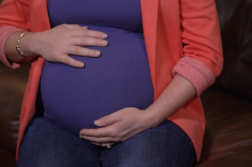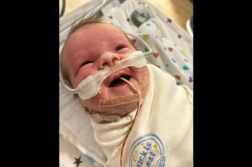CHICAGO, Ill. (Ivanhoe Newswire) – Fibroids are non-cancerous growths in the uterus that can cause heavy bleeding, pain and difficulty getting pregnant. They are the most common type of tumor in women of reproductive age, affecting up to 80 percent of women. According to the National Institutes of Health, 20 percent of women will require surgery, and a hysterectomy is the most common type of surgery performed. There are now solutions that are hysterectomy-free.
Six months ago, Angela Lamondi struggled to walk her dog, Max. A four-inch uterine fibroid was causing pain, excessive bleeding and was putting pressure on her bladder. She was given two options – cut it out, with a risk of excessive blood loss, or get a hysterectomy.
“The first opinion told me to just simply have a hysterectomy, which I thought was a bit invasive for my age,” Angela says.
Robert Vogelzang, MD, an interventional radiologist at Northwestern Medicine explains, “The uterus is just not a disposable organ. It’s felt to be that way by many American physicians, and they’re just wrong.”
Dr. Vogelzang teamed up with surgeons to combine two procedures to preserve Angela’s uterus.
“The fibroid was best treated by removal, but first, by taking away its blood supply with the procedure that I do,” he mentions.
Dr. Vogelzang first blocks off the blood supply to the fibroid, causing it to shrink. Then, the surgeons performed a myomectomy and removed the tumor. Using the combination, Angela lost less than a tablespoon of blood, compared to about 25 ounces just doing the myomectomy itself.
“If a woman is told the hysterectomy is her only option, she should absolutely get a second opinion,” Dr. Vogelzang expresses.
Angela is happy she did – saving her uterus and relieving her pain.
Saving the uterus is not only important for women who still want to have children, but removing it is also associated with pelvic floor dysfunction, urinary incontinence, premature menopause and declines in sexual function.
Contributors to this news report include: Marsha Lewis, Producer; Kirk Manson, Videographer; Roque Correa, Editor.
To receive a free weekly e-mail on medical breakthroughs from Ivanhoe, sign up at: http://www.ivanhoe.com/ftk
Source:
MEDICAL BREAKTHROUGHS
RESEARCH SUMMARY
TOPIC: FIBROID FREEDOM: A HYSTERECTOMY-FREE SOLUTION
REPORT: MB #5309
BACKGROUND: Uterine fibroids, also known as leiomyomas or myomas, are noncancerous growths of the uterus that often appear during childbearing years. These tumors are made up of muscle cells and other tissues and can vary in size, ranging from tiny seedlings that are not visible to the naked eye to bulky masses that can distort and enlarge the uterus. Most women will experience uterine fibrosis by age 50. They are the most common kind of tumor in women in the reproductive age category and can affect up tp 80 percent of those women.
DIAGNOSING: The diagnosis of uterine fibroids typically involves a combination of medical history, physical examination, and imaging studies. Many people wh experience uterine fibroids do not have any symptoms. The people who do experience symptoms can be influenced by the size and number of fibroids they are experiencing. The most common symptoms include heavy menstral bleeding, longer periods, more frequent periods, pelvic pressure and pain, more frequent urination, bloating, constipation, and pain in the lower stomach and back during intimacy.
NEW TECHNOLOGY: The Acessa procedure is a new minimally-invasive same day outpatient therapy for all sizes and types of fibroids. It accounts for fibroids in all places of the uterine wall. This new technology is used through a procedure called radiofrequency ablation. Each of the fibroids is destroyed through applying energy through a small needle array. The existing tissue around remains unaffected and the destroyed tissue has the ability to be completely reabsorbed.
FOR MORE INFORMATION ON THIS REPORT, PLEASE CONTACT:
Erin Valle
If this story or any other Ivanhoe story has impacted your life or prompted you or someone you know to seek or change treatments, please let us know by contacting Marjorie Bekaert Thomas at mthomas@ivanhoe.com




